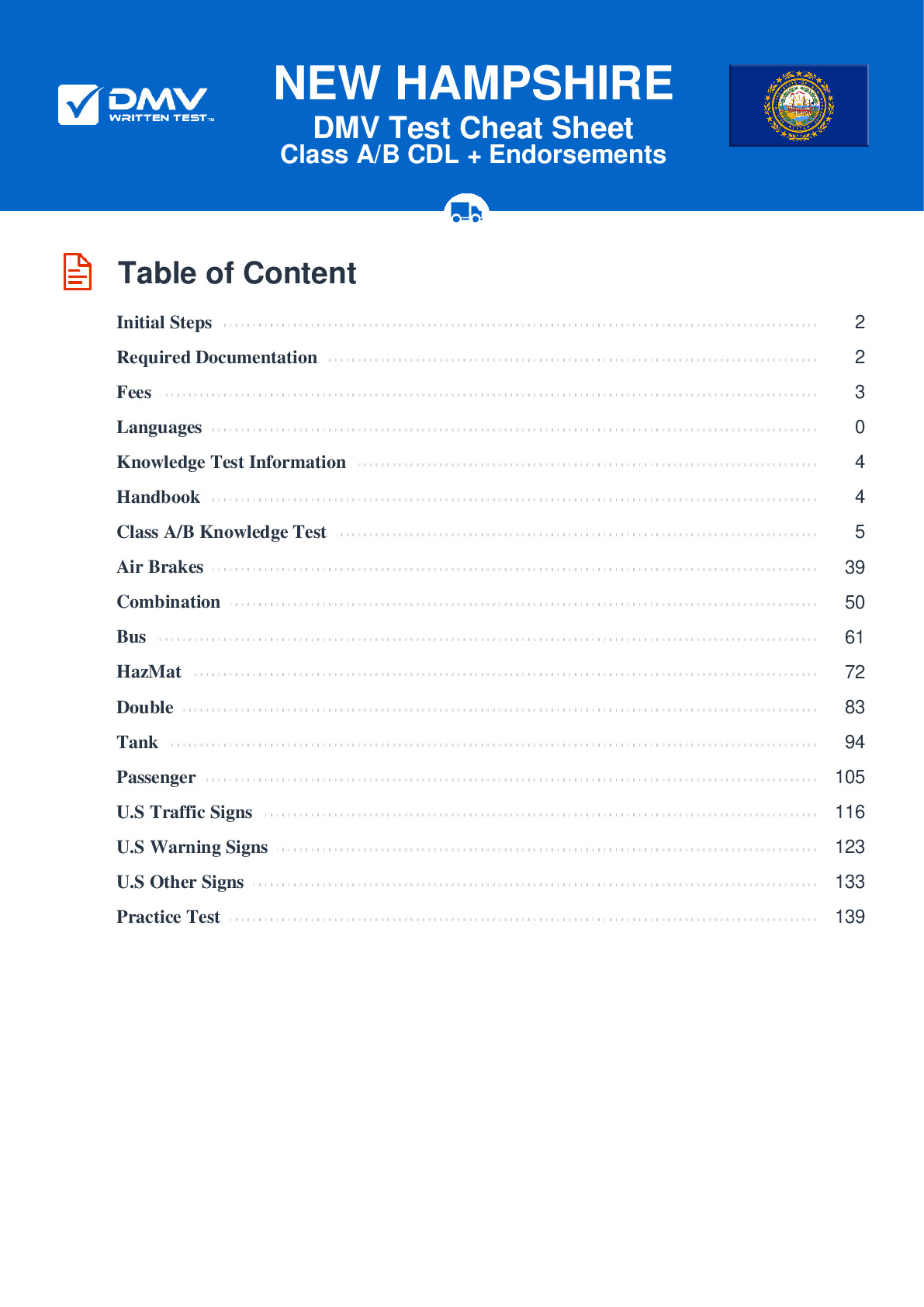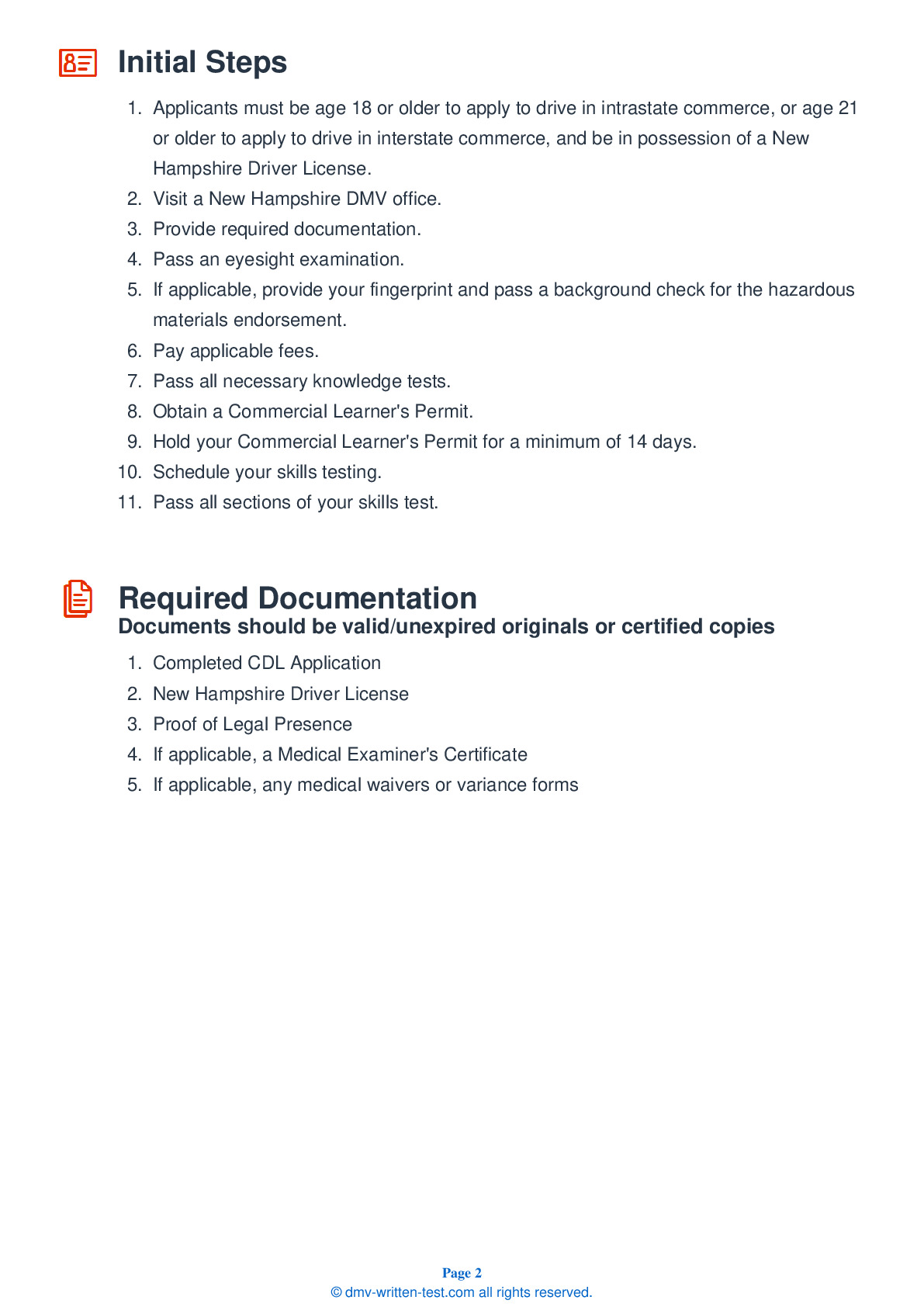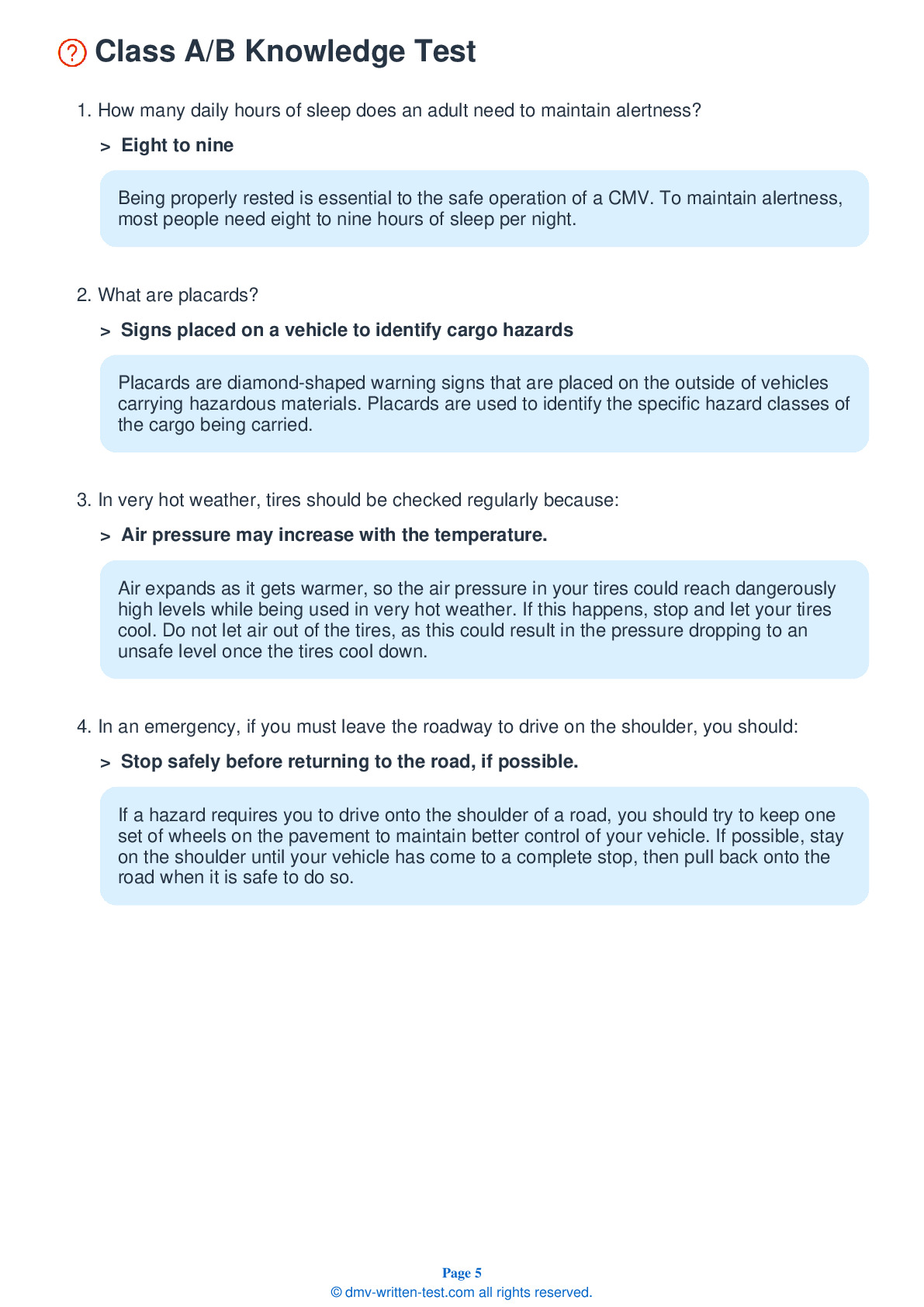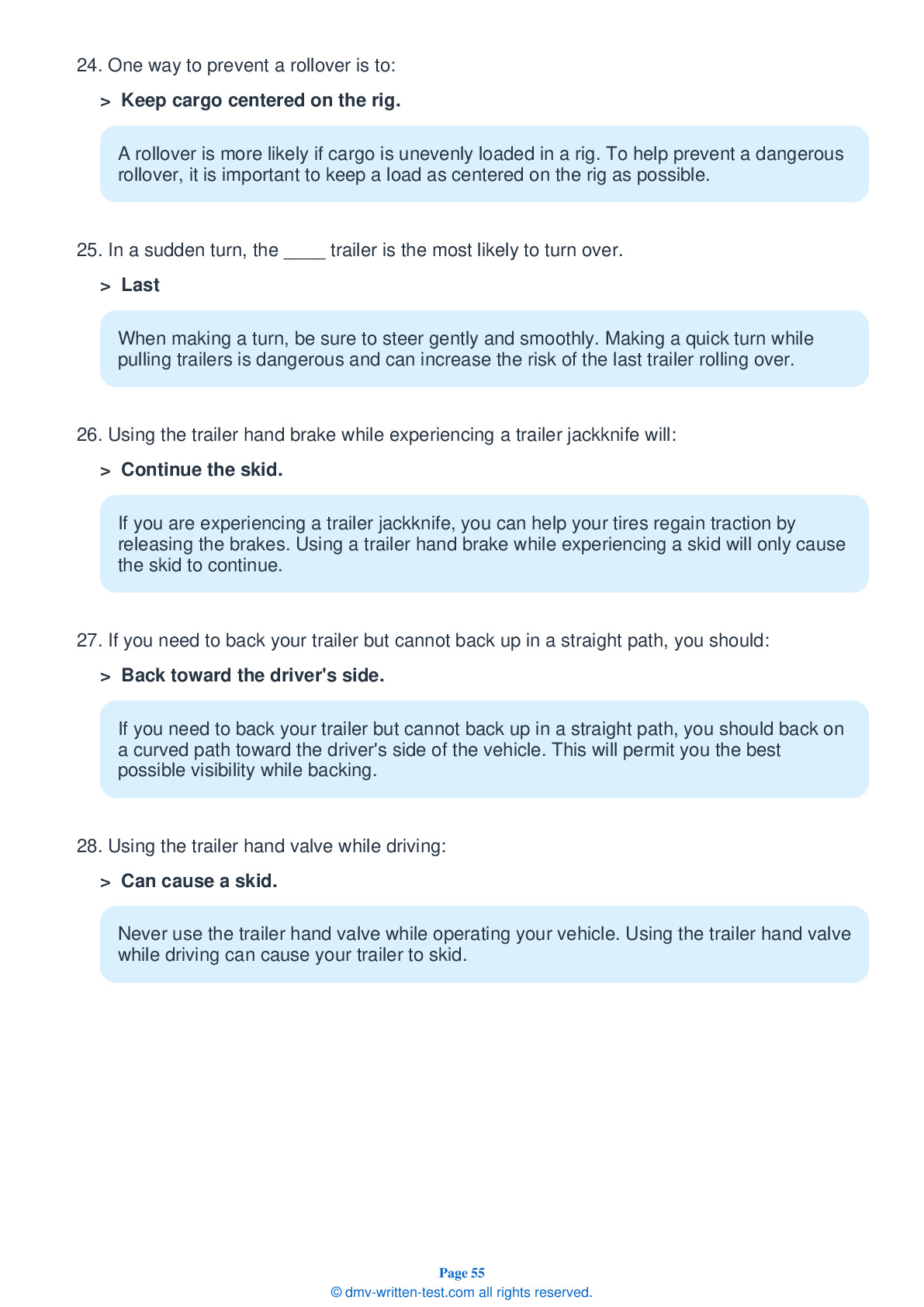Knowledge Test Class A
This license is required for driving any legal combination of vehicles, with a gross combination weight rating of 26,001 pounds or more, provided the GVWR of a trailer exceeds 10,000 pounds To receive this license, applicants must pass a 50-question test. To pass, applicants must answer 40 questions correctly. Each question has four possible answer choices. Test questions come from the New Hampshire CDL Driver’s Guide. Questions come from chapters covering: Introduction, Driving Safely, Transporting Cargo Safely, Air Brakes (if applicable), Combination, Doubles and Hazardous Materials. Endorsements that may be used with a Class A CDL are: Hazardous materials, Tank, Passenger, HazMat and Tank, Air Brakes and School bus.
Number of Question
Passing Score
43. When driving, you should stop and take a break ____ to avoid becoming too tired.
Explanation
To reduce the chances of becoming fatigued on a long trip, a driver should stop for a break at least once every two hours or 100 miles driven.
44. Of the following, which is the most slippery surface?
Explanation
Ice becomes wet when the weather is just warm enough to melt the ice slightly. Wet ice is much more slippery than ice that is not wet.
45. How is water and compressor oil removed from the bottom of an air storage tank?
Explanation
Water and compressor oil are removed from air storage tanks through a drain valve. The water and oil can damage the brakes if left to accumulate in the system. Manually operated tanks must be drained every day to remove this build-up.
46. Backing with a trailer is dangerous because:
Explanation
Backing up is always dangerous because it is impossible to see everything that is behind you. Only drive in reverse if it is absolutely necessary.
47. Headlights:
Explanation
To improve visibility, you should use high beam headlights at night where it is safe and legal to do so. However, the glare from high beam lights can blind other drivers. You should dim your lights to their low beam setting when driving within 500 feet of an approaching vehicle.
48. To determine if a vehicle can handle a load, you must know:
Explanation
It is a driver's responsibility to make sure their vehicle is not overloaded. They must be aware of legal weight limits and the maximum weight that their vehicle is rated to carry, including the weight capacity rating of the suspension system.
49. If you plan to transport hazardous materials, you will:
Explanation
You must have a hazardous materials endorsement to transport any hazardous materials that require the vehicle to be placarded.
50. When driving on a long downhill slope, you should brake by:
Explanation
When approaching a long downgrade, you should shift into a lower gear then use proper braking techniques. Using the brakes alone could cause them to overheat and fail. The braking power of the engine, which is maximized by being in a lower gear, will be the principal way of controlling your speed on a downgrade.
Frequently Asked Questions
A Class A Commercial Driver's License (CDL) in New Hampshire allows drivers to operate a combination of vehicles with a total weight of 26,001 pounds or more, provided that the vehicle being towed weighs more than 10,000 pounds. This license also allows drivers to operate vehicles with a weight of 26,001 pounds or more that are designed to transport 16 or more passengers (including the driver) or hazardous materials.
To obtain a Class A CDL in New Hampshire, you must first obtain a commercial learner's permit (CLP) and pass the required knowledge and skills tests. You must also meet specific eligibility requirements, such as being at least 18 years old (21 years old for interstate driving) and having a clean driving record. Additionally, you may need to complete specialized training and obtain endorsements for certain types of vehicles or cargo.
To obtain a Class A CDL in New Hampshire, you must first obtain a commercial learner's permit (CLP) and pass the required knowledge and skills tests. You must also meet specific eligibility requirements, such as being at least 18 years old (21 years old for interstate driving) and having a clean driving record. Additionally, you may need to complete specialized training and obtain endorsements for certain types of vehicles or cargo.
With a Class A CDL license in New Hampshire, you can operate a combination of vehicles with a total weight of 26,001 pounds or more, provided that the vehicle being towed weighs more than 10,000 pounds. This includes tractor-trailers, truck and trailer combinations, and livestock carriers.
You can also operate vehicles with a weight of 26,001 pounds or more that are designed to transport 16 or more passengers (including the driver) or hazardous materials. This includes buses and vehicles used to transport hazardous materials such as chemicals or explosives.
It's important to note that certain endorsements may be required for specific types of vehicles or cargo. For example, you may need a tanker endorsement to transport liquid cargo in a tank vehicle or a hazardous materials endorsement to transport hazardous materials.
You can also operate vehicles with a weight of 26,001 pounds or more that are designed to transport 16 or more passengers (including the driver) or hazardous materials. This includes buses and vehicles used to transport hazardous materials such as chemicals or explosives.
It's important to note that certain endorsements may be required for specific types of vehicles or cargo. For example, you may need a tanker endorsement to transport liquid cargo in a tank vehicle or a hazardous materials endorsement to transport hazardous materials.
To obtain a Class A CDL license in New Hampshire, you must meet the following requirements:
1. Be at least 18 years old for intrastate driving or 21 years old for interstate driving.
2. Hold a valid New Hampshire driver's license.
3. Pass a medical examination to ensure you meet the physical requirements for operating a commercial vehicle.
4. Obtain a commercial learner's permit (CLP) by passing the required knowledge tests for the type of vehicle you plan to operate.
5. Complete behind-the-wheel training with a qualified instructor or employer.
6. Pass the CDL skills test, which includes a pre-trip inspection, basic control skills, and on-road driving test.
7. Provide proof of U.S. citizenship or lawful permanent residency.
8. Provide your Social Security number.
It's important to note that additional requirements may apply depending on the type of vehicle or cargo you plan to transport. For example, you may need to obtain specialized endorsements such as a hazmat endorsement or tanker endorsement.
1. Be at least 18 years old for intrastate driving or 21 years old for interstate driving.
2. Hold a valid New Hampshire driver's license.
3. Pass a medical examination to ensure you meet the physical requirements for operating a commercial vehicle.
4. Obtain a commercial learner's permit (CLP) by passing the required knowledge tests for the type of vehicle you plan to operate.
5. Complete behind-the-wheel training with a qualified instructor or employer.
6. Pass the CDL skills test, which includes a pre-trip inspection, basic control skills, and on-road driving test.
7. Provide proof of U.S. citizenship or lawful permanent residency.
8. Provide your Social Security number.
It's important to note that additional requirements may apply depending on the type of vehicle or cargo you plan to transport. For example, you may need to obtain specialized endorsements such as a hazmat endorsement or tanker endorsement.
The minimum age requirement for a Class A CDL license in New Hampshire is 18 years old for intrastate driving, which means driving within the state's borders only. For interstate driving, which means driving across state lines, the minimum age requirement is 21 years old.
It's important to note that certain endorsements may have additional age requirements. For example, to obtain a hazmat endorsement, you must be at least 21 years old. Additionally, some employers may have their own age requirements for hiring drivers.
It's important to note that certain endorsements may have additional age requirements. For example, to obtain a hazmat endorsement, you must be at least 21 years old. Additionally, some employers may have their own age requirements for hiring drivers.
It depends on the type of vehicle or cargo you plan to transport. In general, to operate a Class A commercial vehicle in New Hampshire, you will need a Class A CDL license.
However, you may need to obtain additional endorsements depending on the type of cargo you will be transporting. For example, if you plan to transport hazardous materials, you will need to obtain a hazmat endorsement. If you plan to transport passengers, you will need to obtain a passenger endorsement.
Other endorsements that may be required include:
- Tanker endorsement: for drivers who will be transporting liquid or gaseous materials in bulk containers.
- Double/triple trailer endorsement: for drivers who will be operating vehicles with multiple trailers.
- Combination of hazardous materials and tanker endorsements: for drivers who will be transporting hazardous materials in tank vehicles.
To obtain an endorsement, you must pass a knowledge test specific to the type of endorsement you are seeking, as well as any additional requirements such as a background check for the hazmat endorsement.
However, you may need to obtain additional endorsements depending on the type of cargo you will be transporting. For example, if you plan to transport hazardous materials, you will need to obtain a hazmat endorsement. If you plan to transport passengers, you will need to obtain a passenger endorsement.
Other endorsements that may be required include:
- Tanker endorsement: for drivers who will be transporting liquid or gaseous materials in bulk containers.
- Double/triple trailer endorsement: for drivers who will be operating vehicles with multiple trailers.
- Combination of hazardous materials and tanker endorsements: for drivers who will be transporting hazardous materials in tank vehicles.
To obtain an endorsement, you must pass a knowledge test specific to the type of endorsement you are seeking, as well as any additional requirements such as a background check for the hazmat endorsement.
The Class A CDL skills test is broken down into three parts: the pre-trip inspection test, the basic vehicle control test, and the on-road driving test.
1. Pre-trip inspection test: This tests your ability to inspect your vehicle for safety issues before driving. You will need to demonstrate your knowledge of the vehicle's components and systems, and identify any issues that could affect the safety of the vehicle or its cargo.
2. Basic vehicle control test: This tests your ability to control the vehicle in a controlled environment. You will need to demonstrate your ability to perform maneuvers such as backing up, turning, and parking.
3. On-road driving test: This tests your ability to drive the vehicle on public roads safely and responsibly. You will need to demonstrate your ability to obey traffic laws, anticipate hazards, and drive defensively.
During the skills test, you will be evaluated by a licensed CDL examiner who will score you based on your performance in each section. To pass the skills test and obtain a Class A CDL license, you must pass each section with a minimum score of 80%.
1. Pre-trip inspection test: This tests your ability to inspect your vehicle for safety issues before driving. You will need to demonstrate your knowledge of the vehicle's components and systems, and identify any issues that could affect the safety of the vehicle or its cargo.
2. Basic vehicle control test: This tests your ability to control the vehicle in a controlled environment. You will need to demonstrate your ability to perform maneuvers such as backing up, turning, and parking.
3. On-road driving test: This tests your ability to drive the vehicle on public roads safely and responsibly. You will need to demonstrate your ability to obey traffic laws, anticipate hazards, and drive defensively.
During the skills test, you will be evaluated by a licensed CDL examiner who will score you based on your performance in each section. To pass the skills test and obtain a Class A CDL license, you must pass each section with a minimum score of 80%.
Yes, there are some restrictions or limitations for drivers with a Class A CDL license in New Hampshire.
1. Double/Triple Trailers: If a driver passes the skills test with a double/triple trailer endorsement, they are restricted to towing double and triple trailers only.
2. Tank Vehicles: If a driver passes the skills test with a tanker endorsement, they are restricted to transporting liquid and gaseous materials in tank vehicles only.
3. Passenger Transport: If a driver passes the skills test with a passenger endorsement, they are restricted to transporting passengers only.
4. Hazmat Transport: If a driver passes the skills test with a hazmat endorsement, they are required to follow additional regulations related to the handling and transportation of hazardous materials.
5. Air Brakes: If a driver does not pass the skills test with an air brakes endorsement, they are restricted to driving only vehicles without air brakes.
6. Automatic Transmission: If a driver takes the skills test in a vehicle with an automatic transmission, they will receive an endorsement that restricts them from operating vehicles with manual transmissions.
It's important for drivers to know and follow these restrictions or limitations to avoid penalties and keep their CDL license in good standing.
1. Double/Triple Trailers: If a driver passes the skills test with a double/triple trailer endorsement, they are restricted to towing double and triple trailers only.
2. Tank Vehicles: If a driver passes the skills test with a tanker endorsement, they are restricted to transporting liquid and gaseous materials in tank vehicles only.
3. Passenger Transport: If a driver passes the skills test with a passenger endorsement, they are restricted to transporting passengers only.
4. Hazmat Transport: If a driver passes the skills test with a hazmat endorsement, they are required to follow additional regulations related to the handling and transportation of hazardous materials.
5. Air Brakes: If a driver does not pass the skills test with an air brakes endorsement, they are restricted to driving only vehicles without air brakes.
6. Automatic Transmission: If a driver takes the skills test in a vehicle with an automatic transmission, they will receive an endorsement that restricts them from operating vehicles with manual transmissions.
It's important for drivers to know and follow these restrictions or limitations to avoid penalties and keep their CDL license in good standing.
No, the Class A CDL written test in New Hampshire is only available in English. All CDL drivers are required to have a good understanding of the English language, as it is the primary language used in the trucking industry and by law enforcement officials.
However, if you require assistance with the written test due to a disability or a language barrier, you may request accommodations from the New Hampshire DMV. These accommodations may include an interpreter or an extended testing time. You will need to provide documentation of your disability or language barrier and submit a request for accommodations in advance of your scheduled testing date.
However, if you require assistance with the written test due to a disability or a language barrier, you may request accommodations from the New Hampshire DMV. These accommodations may include an interpreter or an extended testing time. You will need to provide documentation of your disability or language barrier and submit a request for accommodations in advance of your scheduled testing date.
Yes, you may request accommodations for the Class A CDL written test in New Hampshire due to a disability. The New Hampshire DMV provides reasonable accommodations to individuals with disabilities who need assistance with the CDL written test.
To request accommodations, you will need to fill out the "Request for Accommodation for Road Test or Written Test" form and submit it to the DMV along with documentation of your disability. This documentation may include a letter from your doctor or healthcare provider, an Individualized Education Plan (IEP), or other supporting documents.
Examples of accommodations that may be provided include additional testing time, a separate testing room, a reader or scribe to assist with the test, or assistive technology.
It's important to submit your request for accommodations well in advance of your scheduled testing date to allow time for the DMV to review and approve your request.
To request accommodations, you will need to fill out the "Request for Accommodation for Road Test or Written Test" form and submit it to the DMV along with documentation of your disability. This documentation may include a letter from your doctor or healthcare provider, an Individualized Education Plan (IEP), or other supporting documents.
Examples of accommodations that may be provided include additional testing time, a separate testing room, a reader or scribe to assist with the test, or assistive technology.
It's important to submit your request for accommodations well in advance of your scheduled testing date to allow time for the DMV to review and approve your request.
If you fail the Class A CDL written test in New Hampshire, you will be allowed to retake the test after a certain period, usually within a week. The exact waiting period and number of retakes allowed may vary depending on the state and the type of CDL endorsement you are testing for.
In New Hampshire, if you fail the written test, you must wait at least one day before you can retake it. You are allowed to retake the test up to two times within a 60-day period. If you fail the test three times within a 60-day period, you must wait at least six months before you can attempt to take the test again.
It's important to prepare for the CDL written test thoroughly before taking it. You can find study materials online or through commercial driving schools. You can also review the New Hampshire CDL manual, which covers all the information and skills necessary to pass the written and skills tests for a CDL license.
In New Hampshire, if you fail the written test, you must wait at least one day before you can retake it. You are allowed to retake the test up to two times within a 60-day period. If you fail the test three times within a 60-day period, you must wait at least six months before you can attempt to take the test again.
It's important to prepare for the CDL written test thoroughly before taking it. You can find study materials online or through commercial driving schools. You can also review the New Hampshire CDL manual, which covers all the information and skills necessary to pass the written and skills tests for a CDL license.




